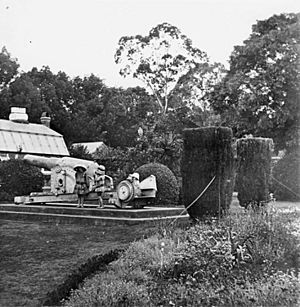RML 64-pounder 64 cwt gun facts for kids
Quick facts for kids RML 64-pounder 64 cwt gun |
|
|---|---|

Fortification mounted MK III gun firing at Fort Glanville Conservation Park, South Australia
|
|
| Type | Naval gun Fortification gun |
| Place of origin | United Kingdom |
| Service history | |
| In service | 1865–190? |
| Used by | British Empire |
| Production history | |
| Designer | Woolwich Arsenal |
| Designed | 1864 |
| Manufacturer | Woolwich Arsenal Elswick Ordnance Company |
| Variants | Mk I, II, III |
| Specifications | |
| Mass | 64-long-hundredweight (3,300 kg) |
| Length | 9 ft 10 inches |
| Barrel length | 97.5 inches bore |
|
|
|
| Shell | 64 pounds (29 kg) |
| Calibre | 6.3 inches (160 mm) |
| Action | RML |
| Breech | None – muzzle-loading |
| Muzzle velocity | Wrought-iron tube : 1,252 feet per second (382 m/s) Mk III steel tube : 1,390 feet per second (420 m/s) |
| Effective firing range | 5,000 yards (4,600 m) |
The RML 64-pounder 64 cwt gun is a Rifled, Muzzle Loading (RML) naval, field or fortification artillery gun manufactured in England in the 19th century, which fired a projectile weighing approximately 64 pounds (29 kg). "64 cwt" refers to the gun's weight rounded up to differentiate it from other "64-pounder" guns.
Contents
Description
The calibre of 6.3 inches was chosen to enable it to fire remaining stocks of spherical shells originally made for the obsolete 32 pounder guns if necessary.
Mark I (adopted in 1864) and Mark II (adopted 1866) guns, and Mark III guns made from 1867 – April 1871 had wrought-iron inner "A" tubes surrounded by wrought-iron coils.
Mark III guns made after April 1871 were built with toughened mild steel "A" tubes, and earlier Mark III guns were re-tubed with steel and were classified as a siege gun in land service. Remaining guns with iron tubes were used for sea service.
Rifling of all guns consisted of 3 grooves, with a uniform twist of 1 turn in 40 calibres (i.e. 1 turn in 252 inches).
Ammunition
The gun's standard shell was "common shell", for firing on troops in cover, ships and buildings, weighed 57.4 pounds (26.0 kg) when empty with a bursting charge of 7.1 pounds (3.2 kg). Shrapnel shells could also be fired; a 66.6 pounds (30.2 kg) shell with a 9-ounce (260 g) bursting charge propelling 234 metal balls.
Surviving Examples of Guns

- Mark I, Mark II number 164 and Mark III guns at Fort George, near Inverness, Scotland, UK
- Mark III gun number 17, on board HMS Gannet, Chatham Dockyard, UK
- Mark III gun number 294, dated 1867, Nothe Fort, Weymouth, UK
- Mark III gun at Fort Brockhurst, Gosport, UK
- Two Mark III guns, including no. 318 dated 1867 at Pendennis Castle, Cornwall, UK
- Mark III guns number 462 and 463 at Fort Glanville, Adelaide, South Australia
- Mark III gun number 739, dated 1878, Townsville, Queensland, Australia
- Mark III gun number 742 dated 1878 - ex HMQS Otter (Queensland colonial navy) example displayed in Queens Park Toowoomba, Queensland, Australia
- Two Mark III guns, including No 729 dated 1878, at Fort Lytton Historic Military Precinct, Brisbane, Australia
- Lei Yue Mun Fort's Central Battery, Hong Kong
- 6 guns at Fort Siloso, Singapore including Mark III gun Number 767, dated 1874
- RML 64-pr 64 cwt Mk 3 at Albert Park, Auckland, Auckland, New Zealand
Surviving Examples of Ammunition
- RML 64pdr shell that has been fired, and RML 64 fuse at Fort Lytton Historic Military Precinct, Brisbane, Australia
- RML 64pdr Mark I shell (no fuse) is held in the collection of the Australian War Memorial, Canberra
See also
- RML 64-pounder 71 cwt gun : conversion of SBML 8-inch 65 cwt gun


